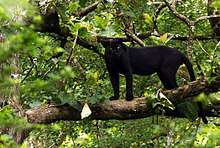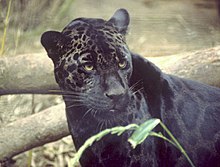Black panther
A black panther is the melanistic colour variant of any Panthera, particularly of the leopard (P. pardus) in Asia and Africa, and the jaguar (P. onca) in the Americas. Black panthers of both species have excess black pigments, but their typical spotted markings are also present. Melanism in the leopard is caused by a recessive allele, and in the jaguar by a dominant allele.
Leopard

In 1788, Jean-Claude Delamétherie described a black leopard that was kept in the Tower of London and had been brought from Bengal.[1] In 1794, Friedrich Albrecht Anton Meyer proposed the scientific name Felis fusca for this individual, the Indian leopard.[2] In 1809, Georges Cuvier described a black leopard kept in the Ménagerie du Jardin des plantes that had been brought from Java. Cuvier proposed to name it Felis melas, the Javan leopard.[3] By 1929, the Natural History Museum, London also had skins of black leopards collected in South Africa and Kanara in southern India.[4]
Melanism in the leopard is conferred by a recessive allele.[5] Melanistic and non-melanistic animals can be littermates. It is thought that melanism confers a selective advantage under certain conditions since it is more common in regions of dense forest, where light levels are lower. Preliminary studies also suggest that melanism might be linked to beneficial mutations in the immune system.[6] The typical spotted markings are present but hidden due to the excess black pigments, which is called "ghost rosettes".[7]
In North Africa, dark African leopards (P. p. pardus) were reported in the Atlas Mountains.[8] A black leopard was sighted in the alpine zone of Mount Kenya.[9] In 2019, a black leopard was recorded in Kenya's Laikipia County.[10][11]
Frequency of melanism appears to be approximately 11% over the leopard's range. Data on the distribution of leopard populations indicates that melanism occurs in five subspecies in the wild: Indian leopard, Javan leopard, African leopard, Indochinese leopard (P. p. delacouri) and Sri Lankan leopard (P. p. kotiya). Based on records from camera traps, melanistic leopards occur foremost in tropical and subtropical moist forests.[12] Melanistic leopards are common in Java, and are also reported from densely forested areas in southwestern China, Myanmar, Assam and Nepal, from Travancore, and some parts of southern India where they may be more numerous than spotted leopards. Most leopards recorded at 16 sites south of the Kra Isthmus between 1996 and 2009 were black, indicating a near fixation of melanism in peninsular Malaysia.[13]
The taxonomic status of captive black leopards and the extent of hybridization between the Javan leopard and other leopard subspecies is uncertain. Therefore, coordinated breeding programs for black leopards do not exist in European and North American zoos.[14] Black leopards occupy space needed for breeding endangered leopard subspecies and are not kept within the North American Species Survival Plan.[15][16]
Two black Amur leopard (P. p. orientalis) cubs were born in zoos.[17][18]
A pseudo-melanistic leopard has a normal background color, but the spots are more densely packed than normal and merge to obscure the golden-brown background color. Any spots on the flanks and limbs that have not merged into the mass of swirls and stripes are unusually small and discrete, rather than forming rosettes. The face and underparts are paler and dappled like those of ordinary spotted leopards.[19]
Jaguar


In 1801, Félix de Azara described a black jaguar observed by local people near the Paraná River in Paraguay.[20] In 2004, a black jaguar was recorded in Mexico's Sierra Madre Occidental.[21] In 2009, a black jaguar was recorded for the first time in Costa Rica's Alberto Manuel Brenes Biological Reserve.[22] In the mountains of the Cordillera de Talamanca, 104 records of jaguars were obtained between 2010 and 2019; 26 of them showed melanistic jaguars.[23]
Melanism in the jaguar is caused by deletions in the melanocortin 1 receptor gene and conferred by a dominant allele.[24]
Cougar
There is no authenticated case of a truly melanistic cougar. None was photographed or killed in the wild, and none has ever been bred. Unconfirmed sightings known as the "North American black panther" are currently attributed to errors in species identification by non-experts, and by the mimetic exaggeration of size.[25]
Culture and literature
- Bagheera in The Jungle Book by Rudyard Kipling (1894) is a black Indian leopard that mentors the human character Mowgli.[26]
- Cornell Woolrich's novel Black Alibi (1942) features a black jaguar that escapes from captivity and wreaks havoc in a Mexican town.[27]
- Walter Van Tilburg Clark's novel Track of the Cat (1949) features a marauding cougar that is supposed to be "the black panther" from a local legend[28]
- The NFL football team Carolina Panthers is named after a black panther, with a logo resembling the animal.
- The National Rugby League team Penrith Panthers is named after the black panther, with a logo of the animal.
See also
- Black cat
- Black dog syndrome
- Black squirrel
- Black tiger
- White panther
References
- Delamétherie, J.-C. (1788). "Description d'une Panthère noire" [Description of a black Panther]. Observations et Mémoires sur la Physique, sur l'Histoire Naturelle et sur les Arts et Métiers, etc. (in French). 33: 45.
- Meyer, F. A. A. (1794). "Über de la Metheries schwarzen Panther [About de la Metheries black Panther]". Zoologische Annalen (in German). Erster Band. Weimar: Im Verlage des Industrie-Comptoirs. pp. 394–396.
- Cuvier, G. (1809). "Recherches sur les espėces vivantes de grands chats, pour servir de preuves et d'éclaircissement au chapitre sur les carnassiers fossils". Annales du Muséum National d'Histoire Naturelle. XIV: 136–164.
- Pocock, R.I. (1929). "Black panthers – an inquiry". Journal of the Bombay Natural History Society. 33 (3): 693–694.
- Robinson, R. (1970). "Inheritance of the black form of the leopard Panthera pardus". Genetica. 41: 190–197.
- Sunquist, F. (2007). "Malaysian Mystery Leopards". National Wildlife Magazine. 45 (1).
- Schneider, A.; David, V. A.; Johnson, W. E.; O'Brien, S. J.; Barsh, G. S.; Menotti-Raymond, M. & Eizirik, E. (2012). "How the leopard hides its spots: ASIP mutations and melanism in wild cats". PLOS One. 7 (12): e50386. Bibcode:2012PLoSO...750386S. doi:10.1371/journal.pone.0050386. PMC 3520955. PMID 23251368.
- Pease, A. E. (1913). "Of dangerous game". The Book of the Lion. London: John Murray. pp. 46−68.
- Young, T. P. & Evans, M. E. (1993). "Alpine vertebrates of Mount Kenya, with particular notes on the rock hyrax". Journal of the East African Natural History Society. 82 (202): 54−79.
- Wilson, C. (2019). "Wild black leopard photographed in Africa for first time in 100 years". New Scientist.
- "How a 24-year old Samburu Warrior Captured Images of Kenya's Black Leopard". Nalooloo Explorers. 2019.
- Da Silva L. G., K.; Kawanishi, K.; Henschel P.; Kittle, A.; Sanei, A.; Reebin, A.; Miquelle, D.; Stein, A. B.; Watson, A.; Kekule, L. B.; Machado, R. B. & Eizirik, E. (2017). "Mapping black panthers: Macroecological modeling of melanism in leopards (Panthera pardus)". PLOS One. 12 (4): e0170378. Bibcode:2017PLoSO..1270378D. doi:10.1371/journal.pone.0170378. PMC 5381760. PMID 28379961.
- Kawanishi, K.; Sunquist, M.E.; Eizirik, E.; Lynam, A.J.; Ngoprasert, D.; Shahruddin, W.N.W.; Rayan, D.M.; Sharma, D.S.K. & Steinmetz, R. (2010). "Near fixation of melanism in panthers of the Malay Peninsula". Journal of Zoology. 282 (3): 201–206. doi:10.1111/j.1469-7998.2010.00731.x.
- Gippoliti, S. & Meijaard, E. (2007). "Taxonomic uniqueness of the Javan Leopard; an opportunity for zoos to save it". Contributions to Zoology. 76 (1): 55–57. doi:10.1163/18759866-07601005.
- Richardson, D. M. (2001). "A simple analysis of leopard (Panthera pardus) space within EAZA collections". In Hiddinga, B.; Brouwer, K. (eds.). EAZA Yearbook 1999/2000. Amsterdam: EAZA Executive Office. pp. 391–392.
- Swanson, B.; Fletchall, N. & Shoemaker, A. (2003). Felid Taxon Advisory Group North American Regional Collection Plan 2003–2005. Disney’s Animal Kingdom.
- "World's only black Amur leopard cub makes friends with a rabbit". Sputnik. 2010. Retrieved 24 October 2018.
- Parham, D. (2017). "Black Beauty". Zoonooz.
- Gamble, C. (2004). Leopards: Natural History & Conservation. Stillwater, MN: Voyageur Press. ISBN 978-0896586567.
- Azara, F. de (1801). "L'Yagouarété". Essais sur l'histoire naturelle des quadrupedes de la province du Paraguay. 1. Paris: Charles Pougens. pp. 114–132.
- Dinets, V. & Polechla, P. J. (2005). "First documentation of melanism in the jaguar (Panthera onca) from northern Mexico". Cat News. 42: 18. Archived from the original on 26 September 2006.
- Núñez, M.C. & Jiménez, E.C. (2009). "A new record of a black jaguar, Panthera onca (Carnivora: Felidae) in Costa Rica" (PDF). Brenesia. 71: 67–68.
- Mooring, M. S.; Eppert, A. A. & Botts, R. T. (2020). "Natural Selection of Melanism in Costa Rican Jaguar and Oncilla: A Test of Gloger's Rule and the Temporal Segregation Hypothesis". Tropical Conservation Science. 13: 1–15. doi:10.1177/1940082920910364.
- Eizirik, E.; Yuhki, N.; Johnson, W. E.; Menotti-Raymond, M.; Hannah, S. S. & O'Brien, S. J. (2003). "Molecular Genetics and Evolution of Melanism in the Cat Family". Current Biology. 13 (5): 448–453. doi:10.1016/S0960-9822(03)00128-3. PMID 12620197.
- Holbert, C. (2002). "Stranded in the Wasteland: Literary Allusion in The Sharpest Sight". Studies in American Indian Literatures. 14 (1): 3.
- Kipling, R. (1910). The Jungle Book (Reprinted ed.). New York: The Century Co.
- Woolrich, C. (1982). Black Alibi. New York, NY: Ballantine Books. ISBN 0-345-30707-0. OCLC 9160843.
- Van Tilburg Clark, W. (1989). The Track of the Cat. Mattituck, NY: Amereon. ISBN 0-88411-389-2. OCLC 18533849.
External links
- Svidraitė, J. (2020). ""I Could Wait 6 Years For A Moment Like This": Wildlife Photographer Waits 6 Days For A Perfect Leopard And A Black Panther Shot". BoredPanda.